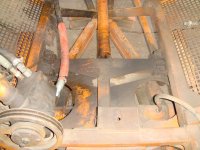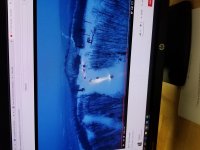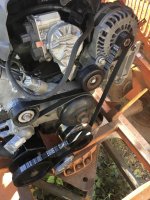As the Snowzilla project progresses we made a major change in our project strategy. With Thundercat we made what we hoped would be all the modifications, and then took it out for testing. Unfortunately, testing revealed some issues that had to be resolved, and then more testing. Only then did we take it completely apart for blasting and painting. Scott and I think that’s the “right” way, but it also takes a fair bit longer. The majority of the modifications we’re doing to Snowzilla are similar to ones we made to Thundercat, so the original plan was to get the items done that require welding, and then remove the few things that have been installed and send it to be blasted and painted. Most everything else would be installed for the first time after painting. But as we were almost ready to send it to the blaster Scott wasn’t comfortable with all that hadn’t been done. He wanted to spend more time and get more systems preliminarily installed. It’s more time consuming, and making that change will kill our goal of a Christmas 2019 ready time, but we think the finished product will be better, and so the plan was changed. Unfortunately that means Snowzilla will be “mothballed” for awhile. WBJ1 needs a snowcat to use at Christmas time, and we need to make certain we have one available for him. The 1986 1544 will be the loaner ‘cat, but it needs some repairs and maintenance before it’s ready for that role. My wife has knee replacement surgery scheduled for early November and I’ll be her primary caregiver once she gets home from the hospital. That will severely restrict the amount of time we have for snowcat projects, so we need to get after the 1544 to ensure readiness at Christmas.
A few posts ago I mentioned I typically write stuff up after the fact as time permits and then make a thread post. That means we’re usually working on something else when a post is made. "Real time”, we're waiting on some parts to finish the hydraulic pump mounting bracket, which also incorporates a belt tensioner. We intend to finish that sub-project before we put Snowzilla on hold. We've also been doing some preliminary work on the wiring system which I’ll explain below. Sadly, no pics in this post.
There are quite a large number of changes to Snowzilla's electrical system; some wires get removed (precious few) and a whole bunch get added. We’re installing a new instrument panel, adding a bunch of additional switches (with four extra switch cut outs for additional future system "growth"). We’re also changing the switch style from the factory Cole Hersee rocker switches, adding a transmission temperature gauge, and it was recently decided to change the existing gauges, too. A nice, clean, logical and professional looking wiring system is the goal. To achieve that, one really needs to spend the time researching the various systems and accessories and determining their respective electrical loads. You also need to measure the length of each wire from the accessory to the power source. That then allows one to select the proper gauge wire. The electrical loads must be compared to the switch amperage rating to see what systems can be controlled with switches, and what systems need relays, and then make a list of what wiring supplies will be needed. That also involves deciding what color wires will serve each function as part of a color-coded schematic. Time spent thinking and organizing is time well spent, as it hopefully prevents having to go back and add stuff that you forgot. (Been there-done that (more than once).)
It can be difficult to find all kinds of different colored wires, and in various gauges. There are only so many solid colors, so pretty soon you start using wires with stripes. These are actually called “tracers”, and one can get tracers in various colors, which really opens up the number of options. Tracers can be straight or spiral, and you can have multiple tracers on a single wire. For example, a white wire with red and blue spiral tracers. From experience, we prefer spiral tracers as whatever angle you look at the wire, you will see the tracer(s) (with a straight tracer pattern that’s not necessarily the case).
As you know, Snowzilla has been in the works for quite some time. A few years ago WBJ1 and I discussed vehicle lighting, and various options for different light functions. Shortly thereafter shipping boxes (plural) started arriving with lights. Knowing we didn’t need them for awhile, Scott and I just stacked the various unopened boxes in a safe, out of the way place. Some of the boxes seemed quite large but I chalked that up to the lights being well protected with lots of packing material. Well, to calculate the wiring needs for these lights, we had to dust off the boxes and open ‘em up to see what was inside, and what the electrical requirements are, so we could order the right supplies.
Far be it for me to suggest WBJ1 went overboard, but Scott and I were quite literally incredulous at what we discovered. The image of WBJ1 ordering lights seemed analogous to that of a young child going to a candy store with Grandma who says “Get whatever you want, I’m buying”. Mind you, all of these are LED lights, not incandescent lights. I don’t want to divulge any specific details at this point, but we added up the electrical requirements of the various LED lights…. OMG!
I’ll pause for a moment and say these lights were bought back when the plan was (or maybe I should rephrase that and say, “when Scott and I thought the plan was”) to use the stock Tucker Chrysler 318 Industrial engine. That engine has a 41 amp alternator, and that number is somewhat ironic because if all the lights are turned on at the same time, the amperage needed to power the abundance of LED lights being installed on Snowzilla is literally twice that! Yup, no kidding, 82.33 amps…just for the lights! I won’t mention the total wattage, but the mathematical formula is volts x amps = watts. It’s a 12 volt system. 12 times 82 = YGTBSM!
I’ll again point out these are LED lights... and they put out roughly FIVE times more light per watt than incandescent lights. I’m not up on the latest conventions of social media but #overkill seems about right….
Picture this scenario:
It’s a clear, dark moonless night. A FedEx MD-11 wide-body cargo plane is enroute from the west coast to Memphis for the evening sort, and is presently over Western Colorado...
FedEx 123: “Denver Center, FedEx one twenty three, do you have time for a question?”
Denver ARTCC (Air Route Traffic Control Center): “Sure thing FedEx one twenty three. Go ahead with your question.”
FedEx 123: “Denver, there’s a really bright, white light in the middle of nowhere at our 1 o’clock position for about 10 miles. Any idea what that is?”
Denver ARTCC: “Roger Fedex one twenty three, we had some inquiries about that earlier. The Montrose County Sheriff’s Department said it’s some knucklehead with a snowcat apparently trying to light up the whole county.”
FedEx 123: “Thanks Denver. If that’s his goal, he’s doing a good job.”

















